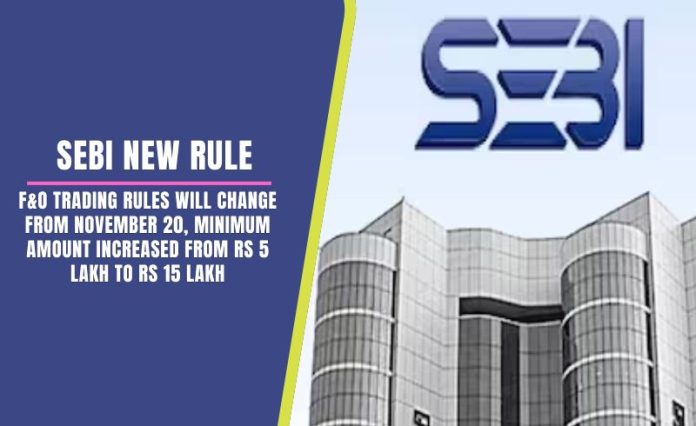SEBI New Rule: SEBI has issued a circular for new rules related to Futures and Options (F&O), stating that these new rules will be effective from November 20.
According to this circular, from February 1, option buyers will have to pay an upfront premium and intra-day position limits will also be monitored. Apart from this, SEBI has fixed the minimum value of index futures contract for derivatives at Rs 15 lakh, while at present it ranges between Rs 5 lakh to Rs 10 lakh.
With the implementation of the new rules, a major change has been made in the contract size of futures and options trading, which aims to better manage the risk of trading. According to SEBI, these changes will be implemented in several phases so that they can be implemented smoothly in the market and traders and investors get the necessary time. These rules are aimed at promoting transparency and security in the futures and options market, as well as ensuring higher pricing for larger contracts, thereby effectively managing the risk and control of trading.
The main reason behind the implementation of the new rules
The main reason behind the implementation of the new rules is the highly risky nature of the derivatives market. SEBI’s current concern is that the participation of retail investors in this market is increasing rapidly. SEBI believes that many investors are entering the derivatives market because they expect to get very high profits from here. However, most of these investors do not have the right information or experience of the derivatives market, due to which they are unknowingly taking huge risks.
The derivatives market is highly volatile and complex, where investing without proper information is likely to result in losses. SEBI aims to reduce such risks through these regulations and ensure that only those investors enter this market who properly understand its functioning and risks.
What is F&O
F&O stands for “Futures and Options”. These are two major derivative instruments of the financial market, which provide investors and traders the right or obligation to buy or sell an asset at a fixed price in the future. Let us understand both of these in detail.
F&O stands for “Futures and Options”. These are two major derivative instruments of the financial market, which provide investors and traders the right or obligation to buy or sell an asset at a fixed price in the future. Let us understand both of these in detail.
1. Futures
- A futures is a type of financial contract in which two parties agree to buy or sell an asset (such as a share, commodity, currency) at a fixed price on a specific date
- Key feature : It is a binding contract. This means that both parties have to honor their commitments on the contract expiry date, regardless of the market price.
- Example : Suppose you are an investor and you think the price of gold will rise. You enter into a futures contract to buy gold today at Rs 50,000 per 10 grams after 3 months. If the price of gold after 3 months becomes Rs 52,000, you will make a profit because you can buy it at Rs 50,000 as per the contract.
Options
- An option is a contract that gives the buyer the right, but not the obligation, to buy or sell an asset at a certain price by a certain date.
- Type :
- Call Option : It gives you the right to buy an asset at a certain price in the future.
- Put Option : It gives you the right to sell an asset at a certain price in the future.
- Key feature : The buyer only has to pay a premium (an upfront amount). If the market goes against their expectation, they lose only the premium amount and not the entire contract value.
- Example : Suppose you have bought a call option on a stock with a strike price of Rs 100 per share, and paid a premium of Rs 5 per share for it. If the stock price rises to Rs 110, you can make a profit. But if it falls to Rs 95, you will not exercise the option and will incur a loss of only Rs 5.



